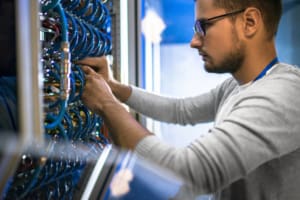Wired Versus Wireless: Balancing Security and Convenience
Choosing between wired and wireless technology solutions continues to be a hot topic among business leaders. Although wireless options have increased in recent years, many businesses are still incorporating wired solutions into their infrastructure — and for good reason. Wired systems have several advantages over their wireless counterparts, chief among them being speed and security.
Need for speed
A strong, reliable internet connection is something we all want and need, but often take for granted — that is, until things slow down or even stop. In today’s digital age, connecting to a wireless router or a mobile hotspot is common. Unfortunately, wireless networks can present challenges, especially with regard to speed. Wi-Fi networks use radio frequencies, measured in gigahertz (GHz), to transmit information between connected devices. These networks leverage frequency bands, which determine the speed and coverage available. For example, a 2.4 GHz band provides more coverage with slower speeds, whereas a 5 GHz band offers faster speeds but with less coverage. The more connections to a wireless network, the greater the likelihood of slower speeds.
Wired networks, in contrast, use an Ethernet cable to connect devices to the network. By most accounts, wired networks are consistently faster than wireless ones. There are several categories of Ethernet cables available, with Cat5 and Cat6 cables as the most popular. Depending on the amount of data traversing through these connections, Ethernet cables can provide a data superhighway for businesses. Cat6a cables, for example, can achieve speeds up to 10 Gbps. These cables also are far less likely to allow for connection issues because they are directly linked to the router and aren’t subject to signal interference from other devices, thereby reducing the possibility of slowdown.
 Locking down security
Locking down security
Data security is a top priority among business leaders, which makes the decision between wired and wireless even more important. The Internet of Things (IoT), for example, has become the next big step nearly every company wants to make, but the security risks are of highest concern. IoT provides even more chinks in the already dented armor of a wireless network, with many devices remaining unprotected and criminally easy to exploit for malicious hackers. Further, connectivity to myriad IoT devices through wireless networks presents a significant challenge for businesses. It’s not just a matter of increasing the number of devices connected to a wireless network, which could affect connection speeds, these added devices mean more technologies to monitor and secure, and more opportunities for risk.
Wired systems avoid most of the risks that accompany IoT, and provide an extra layer of security. Not only is it more difficult for a cybercriminal to gain access to the network without a wireless beacon; it’s also much more difficult to compromise bandwidth. A wired network leverages physical cables and requires individuals to be present within the building to access it. This inherently makes it more secure by restricting access and creating a virtually closed system.
Whether wired or wireless, businesses must implement stronger security practices to ensure the safety and integrity of their data.
Wireless versus wired? It depends.
Do you have a lot of people who need consistent access to the company network? Are you running a security system that you can’t risk shutting down? Do you need a solid network foundation that is consistently available and reliable, regardless of Wi-Fi availability? Wired network connections can help with all of that, with more security than wireless ones could ever hope to promise. Going completely wired isn’t feasible for most companies, especially in light of the shift to remote and hybrid workplaces, but having the in-person workplace remain wired can help with keeping everyone up to date and on the network. Often, businesses will leverage the benefits of both wired and wireless networks, offering greater flexibility, reliability, and security.